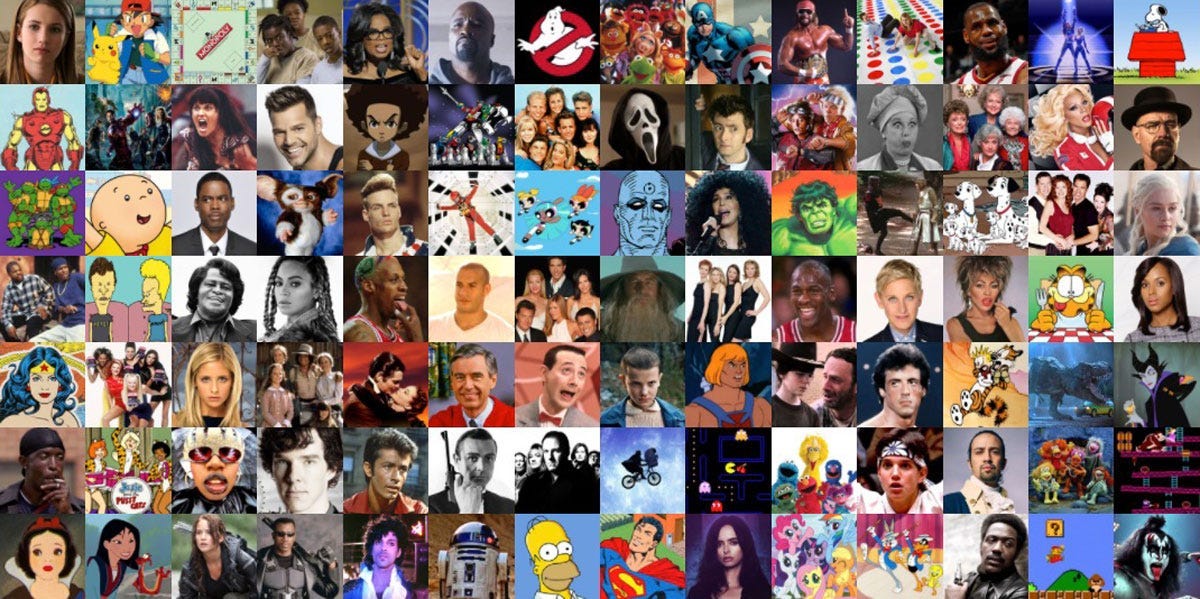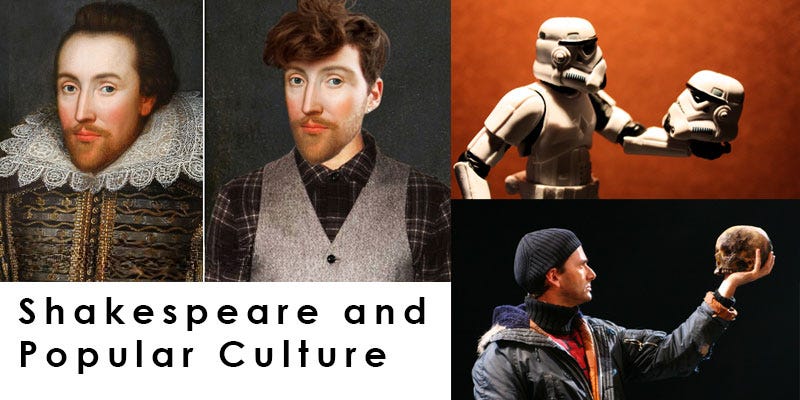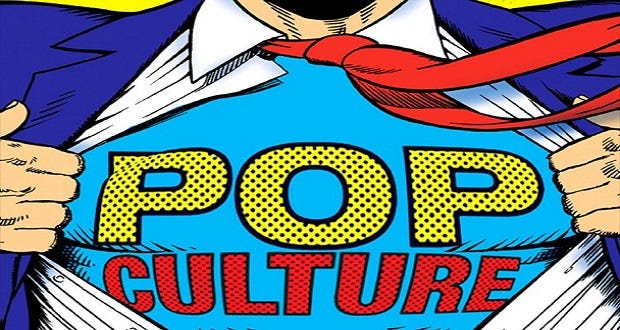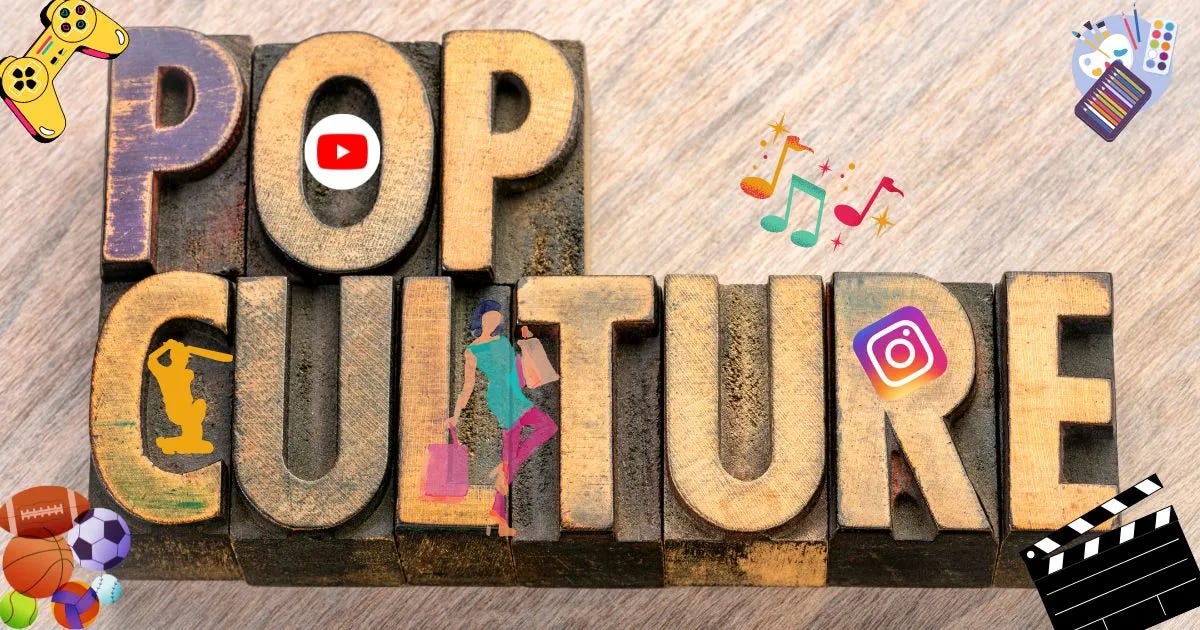Pop Goes the Easel: Art and Entertainment in the Digital Age
Enduring Question #2 (of 3)
Note to The Vestibule’s subscribers: This post reproduces the second of my three contributions to the publishing giant ABC-CLIO’s Enduring Questions Database. Two Greenwood Publishing Group editors, George Butler and Rebecca Matheson, created this project in mid- or late-2009 before soliciting contributions from several dozen scholars, including myself, in early 2010.
My first piece, “Out of the Twilight Zone: American Television Comes of Age,” appeared in the Enduring Questions Database on 1 September 2010, while this essay, “Pop Goes the Easel: Art and Entertainment in the Digital Age,” appeared there on 22 December 2011 (in response to the question “Is Popular Culture Art or Entertainment?”). Like its predecessor, “Pop Goes the Easel” was fun to research, to write, and to revise.
I hope you enjoy it.
I’ve certainly enjoyed revisiting it all these years later.
My introductory note to “Out of the Twilight Zone” mentions that I couldn’t find offprints or screenshots of that piece anywhere, but, after a dogged search, I dug one copy out of the bottom of my campus office’s filing cabinet, along with “Pop Goes the Easel” (yay! huzzah!), so please find a digital version of “Pop Goes the Easel”—alongside other sources mentioned in this essay—in the “Files” section below. I’ve also added digital copies of “Out of the Twilight Zone” to its Vestibule post.
All the best—Jason
Enduring Question
Is Popular Culture Art or Entertainment?
Quick Response
The best answer is “both,” but this either-or / yes-or-no question requires more nuance, thought, and reflection.

1. Sacred & Profane
Although the most satisfying response to this query is “both,” a fuller answer must synthesize the conflicts inherent in the question’s dichotomous expression. Identifying the popular and the artistic—much less distinguishing between them—is difficult enough. What, after all, marks a cultural production as popular? The standards that we apply to this question largely determine our response, while defining art remains as subjective as it ever was.
Popular culture, broadly construed, could entail any cultural text produced at the present moment, whatever that moment is, however we understand the word text, and regardless of that text’s aesthetic reputation. A narrower definition restricts 21st-Century popular culture to film, television, and the Internet (or the World Wide Web, or the online world, or cyberspace, or whatever term you prefer). These electronic media, when perceived as commercial forms rather than artistic venues, divert the public’s attention from the loftier pursuits of reading literary novels, debating political issues, and building civil communities.
This tension—between Word and Image—has long haunted Western societies. In the beginning, after all, was the Word, whose glorious fecundity fashions the universe as humanity’s province, at least according to one widespread (and, dare I say it, popular) story. The Image—far more pernicious in its effects—promotes idolatry, blasphemy, and apostasy, as Moses discovered upon descending Mount Sinai carrying stone tablets that proclaimed a new covenant between the divine and the secular worlds—or so I hear.
This historical inheritance produces a chain of binaries that generates its own stultifying logic: Sacred vs. Profane → Word vs. Image → Art vs. Entertainment. The first term of these dichotomies (to summarize thousands of years of debate in a single word) is highbrow, while the final term is lowbrow. The first is vaunted, while the second is vulgar. The first, venerable; the second, execrable.
We could indefinitely continue this list, but, for the present argument, the most relevant binary opposition relies upon the class snobbery lampooned by William Shakespeare’s comedies, Charlie Chaplin’s films, and John Cleese’s Fawlty Towers (1975-1979): the first term is elite, while the second is popular.
Placing Chaplin and Cleese alongside Shakespeare demolishes this dichotomy in a single sentence, but can’t serve as the final word on this inexhaustible subject. Shakespeare, however, may be the most instructive example. Shakespearean drama and poetry, as any American student who’s survived a middle-school literature class learns, constitute the Greatest Art the World Has Ever Known. Encountering Shakespeare makes us smarter, raises us higher, and improves our lot even if we fail to understand his genius.

The one quality absent from this description is the trait that—regretfully—no longer pertains to Shakespeare, who transcends its tawdry venalities: popular appeal. Or, to state the matter another way, Shakespeare is neither entertainment nor entertaining. The Bard isn’t enjoyable, pleasurable, or diverting for the simple reason that he is—now and forever more—Art Personified, whether we like him or not.
The reaction of students to Shakespeare’s name tells this tale. They resign themselves to days of drudgery because they know, instinctually it seems, that Shakespeare can’t and won’t be fun. Students recognize, before ever reading a single word of Shakespeare’s oeuvre, that they must admire him, that they must praise him, and, worst of all, that they must revere him.
How liberating it can be, then, for students to discover that Shakespeare, in his own day, was popular culture. His plays, as Stephen Greenblatt’s 2004 book Will in the World documents, drew crowds from every social class to the Globe Theatre. And for the price of one penny, spectators could stand on the earthen floor, watch the performance, talk back to the actors, and enjoy the evening.
If this portrait of a night at the Shakespearean theatre sounds fun, the reason for thinking so is simple.
It was fun.

2. Word & Image
What can we make of this paradox? Shakespeare, we’ve heard, is the greatest playwright of the Western world, meaning that he’s the writer who exceeds all others. How could his work be fun or enjoyable or entertaining? Art, after all, is serious. One doesn’t enjoy Art because it’s somber, it’s deep, and, above all, it’s meaningful.
Entertainment, by contrast, is lighthearted, superficial, and mindless. Who would willingly read Shakespeare’s plays when they could watch Vince Gilligan’s sublime television series Breaking Bad (2008-2013) or enjoy Dave Chappelle so adroitly lampooning Rick James, Prince, and George W. Bush on his marvelous Chappelle’s Show (2003-2006) that we can no longer consider these real-life celebrities apart from Chappelle’s devastating satire?
Calling Breaking Bad sublime and Chappelle’s Show marvelous, for people invested in the Art-vs.-Entertainment debate, signals aesthetic relativism of the worst kind. Who but the most ignorant observer would place television programs in the same league as the Bard? Yet Shakespeare’s unassailable cultural reputation explains why Northrop Frye, in the “Polemical Introduction” to his influential 1957 book Anatomy of Criticism, appropriates the Elizabethan Era’s most famous dramatist to illustrate the contention that defining art is a largely subjective game.
Frye’s focus may be literature, but his principles apply to other creative endeavors. Frye suggests that the literary canon comprises a riot of competing opinions that, in the end, is little more than “the literary chit-chat which makes the reputations of poets boom and crash in an imaginary stock exchange.”1

The artistic capital that accrues to certain authors (say, William Shakespeare) can easily grow, diminish, or disappear depending upon how scholarly conversations develop. Even more useful, however, is Frye’s comment that “it is clearly the simple truth that there is no real correlation either way between the merits of art and its public reception.”2 Commercial popularity may not guarantee aesthetic quality, but neither should popular appeal indict a work’s artistic significance. A noteworthy corollary to Frye’s rule is that an author’s popularity within academic circles can’t certify his, her, or their artistry because scholars may hold biases masquerading as unassailable conclusions, but that, in the end, are personal opinions—learned, studied, and, we hope, wise opinions that help us see the work under consideration in new and compelling ways—but opinions nonetheless.
Frye’s ideas have broader resonance because the reputations of marginalized authors, genres, modes, and media depend upon commonly held assumptions that, upon reflection, reveal aesthetic bigotries against them. The printed word may seem sacrosanct to the literati, but its primacy isn’t obvious to the art historian, the dramaturge, the television scholar, and the cineaste. The old tension between Word and Image reasserts itself, even negatively affecting Shakespeare. His plays, after all, were performed for his audience’s visual pleasure. Shakespearean spectacle was as important as the plays’ justly celebrated dialogue, meaning that we may now read them as literary masterworks, but their original reception was as culture popular enough to ensure that at least 37 different productions found their way onto the theatrical stage, which was late-16th- and early-17th-Century England’s version of mass entertainment (alongside, lest we forget, the inhumane spectacle of bearbaiting).
Another necessary stopping point in this Art-vs.-Entertainment tour includes the Frankfurt School writers, none more important than Theodor W. Adorno and Max Horkheimer. Their seminal 1947 book Dialectic as Enlightenment synthesizes so many ideas about popular culture’s low aesthetic significance that electronic mass media have never fully emerged from this text’s argumentative evisceration. Its most famous chapter, indeed, remains the watchword for high-cultural suspicions about pop-cultural perversions: “The Culture Industry: Enlightenment as Mass Deception.” This piece summarizes Adorno’s and Horkheimer’s major thesis that mass media plunge their audiences into intellectual somnambulism by minting homogenized products that promote superficial pleasure over deep understanding, that suspend the audience’s critical faculties, and that blur the border between reality and fantasy.
Adorno and Horkheimer criticize mass entertainment’s consumerist bent for impeding genuine emotional responses, complex thinking, and full imagination. The movies, for instance, enforce their own pace upon viewers to eliminate the imaginative faculty that, the authors assume, characterizes highbrow art. Adorno and Horkheimer, having witnessed the pernicious effects of Nazism’s relentless propaganda, make understandable claims about mass media’s fearsome cultural power, but refuse to acknowledge the possibility that the filmmaker’s art employs numerous techniques for stylizing reality rather than presenting it unadorned. In Adorno’s and Horkheimer’s telling, the moving image can charm its viewers into a preconscious daze that disarms their intellectual defenses. The word, by contrast, permits greater reflection and comprehension.

Adorno hardens his opinions in a later essay, 1967’s “Culture Industry Reconsidered,” but we shouldn’t underestimate the influence of “The Culture Industry” in authorizing all later treatises that suspect mass media of endless perfidies, whether Newton N. Minow’s inaugural address to the National Association of Broadcasters after becoming President John F. Kennedy’s first Federal Communications Commission chairman (1961’s “Television and the Public Interest,” in which Minow famously calls television “a vast wasteland”), Jerry Mander’s 1978 polemic Four Arguments for the Elimination of Television, or Sven Birkerts’s 1994 book The Gutenberg Elegies: The Fate of Reading in an Electronic Age.
This list could also indefinitely continue, but the message is clear: The Image is out to get us. It bewitches and beguiles and entertains and enraptures, but heaven help us if we fall prey to its vulgar allure.
Other imagistic forms—painting, sculpture, and the “fine” arts—are exempt from the aesthetic penitentiary to which Adorno and Horkheimer consign electronic mass media. Painting and sculpture have certainly proven their worth, mostly by surviving so long that they’ve become legitimate art, proving yet again how wise is Noah Cross—John Huston’s character in Roman Polanski’s 1974 film Chinatown (scripted by Robert Towne)—when he tells Jack Nicholson’s private detective J.J. Gittes, “politicians, ugly buildings, and whores all get respectable if they last long enough.” Even photography rates higher than cinema, television, and the Internet by dint of arriving on the cultural scene before they did.
And so, as we conclude this short historical tour, we’ve come full circle: Sacred vs. Profane → Word vs. Image → Art vs. Entertainment.
3. Art & Entertainment
Robert Stam, in his important essay “Beyond Fidelity: The Dialogics of Adaptation,” identifies Western culture’s bias against image-based entertainment as “iconophobia, the culturally rooted prejudice (traceable to the Judaic-Muslim-Protestant prohibitions on ‘graven images’ and to the Platonic and Neoplatonic depreciation of the world of phenomenal appearance) that visual arts are necessarily inferior to the verbal arts.”3 Stam’s assessment isn’t merely correct, but worth pondering in its honest wisdom.
As such, perhaps answering this essay’s fundamental question is easy: Popular culture isn’t art, but entertainment. Perhaps answering it is relative: Popular culture is art if the individual considers it art, entertainment if the individual considers it entertainment, and both if the individual considers it both. Or perhaps answering this query is impossible: Its binary form presumes that popular culture is inartistic, meaning that pop culture enters a fixed fight with both hands tied behind its back.
These possibilities, no matter how they evade the issue, at least point to a provisional response: Answering this question is irrelevant. The easy availability of digital media now renders debating popular culture’s artistry beside the point. Commercialized mass media are here to stay no matter how salubrious or deleterious their effects may (or may not) be.
This intellectually dissatisfying response replies to the original question with a more flippant query: “Who cares?” Yet no amount of handwringing about popular culture’s pervasiveness will wish it away. More pop culture is produced every week than any individual could possibly experience in an entire year, while our attempts to assess pop culture are retrospective enterprises that’ve failed to construct a universal theory by which to answer whether popular culture is art, entertainment, both, or neither.
Even so, we hear so often about the World Wide Web’s democratizing potential that it’s easy to endorse the platitude that all human knowledge and culture will one day be available to every person. Corporate maneuvers like Google’s 2006 decision to censor its search-engine results to gain access to Chinese markets and ongoing threats to FCC policies maintaining network neutrality, however, contradict breathless visions of utopian information access liberating humanity from the shackles of intellectual ignorance and cultural poverty.

The disunited global village sketched by Marshall McLuhan in his 1962 book The Gutenberg Galaxy and 1964’s Understanding Media may have arrived earlier than expected, but this development, far from superseding the question of whether pop culture is art or entertainment, instead argues for synthesizing these options. Such binaries rule out the many nuanced approaches we might take to this query while ignoring the fact, if not the truth, that today’s popular culture may become tomorrow’s canonical art. Francine Prose puts it well in “Ten Things Art Can Do for Us,” her stirring address upon receiving Washington University in St. Louis’s International Humanities Medal (now called the International Humanities Prize) in November 2010, when she states, “Art can be beautiful” before confessing that “unraveling the word beauty can get us so ensnarled that it’s no wonder that for a time critics and academics and even some artists agreed that it was probably better not to use it at all.”4
Prose then cites, in order, Hieronymus Bosch’s 16th-Century triptych The Garden of Earthly Delights, Paul Cézanne’s 1893-1894 painting Still Life with Apples, Mavis Gallant’s 1963 short story “The Ice Wagon Going Down the Street,” Dezso Kosztolányi’s 1924 novel Skylark, Mike Leigh’s 1990 film Life Is Sweet, Francis Ford Coppola’s 1972 film The Godfather, and “every moment of Michael K. Williams’s portrait of Omar Little in David Simon’s The Wire”5 to enact the cultural leveling that mentioning Shakespeare, Chaplin, and Fawlty Towers in the same breath performs. Prose, not content to let the matter rest here, concludes her speech with its most important point: “Art can give us pleasure.”6
Art, in other words, can entertain and, indeed, should entertain. Prose certainly thinks so, stating the matter this way:
How fortunate, then, that we have art to amuse us, move us, comfort us, protect us, and console us for what we already know: that life is strange and hard and often dark, and we should be grateful, more than grateful, for those pinpoints of radiance, the cord of runway lights that guides us back through time and death to the hand which first drew that antelope on the wall.7
Entertainment isn’t a dirty word, art isn’t a bore, and pleasure isn’t a sin. We can love King Lear, Breaking Bad, Christina Rossetti’s poetry, Octavia E. Butler’s novels, Beethoven’s symphonies, and Omar Little’s machinations in equal measure because the distinctions between elitist and popular art pertain only when we hope, wish, or need them to do so.
This conclusion also permits us to disdain Romeo and Juliet, Baywatch, Herman Melville’s poetry, Harold Robbins’s novels, Robert Schumann’s later compositions, and Cordell Walker (Texas Ranger) if we wish. This discussion won’t prevent their admirers from valuing and enjoying them.
Nor should it.

Yet where do these observations leave popular culture? In an aesthetic netherworld, a critical limbo, or a scholarly no-man’s-land where only provisional responses are likely? If so, we’d be right to despair that a coherent reply is possible to this essay’s opening question.
The situation, however, isn’t so bleak. One answer—provisional and ambiguous and indefinite, to be sure, but also happy—returns us to the Bard by way of the TARDIS. In the deliriously entertaining 2007 Doctor Who episode “The Shakespeare Code” (a title that deliberately recalls a certain Dan Brown bestseller), the Doctor (David Tennant) and his companion, Martha Jones (Freema Agyeman), travel to 1599 London to watch a live performance of Love’s Labour’s Lost at the Globe Theatre, after which Shakespeare himself (Dean Lennox Kelly) addresses the rowdy audience by shouting “Shut your big fat mouths!” This wonderful moment acknowledges Shakespeare’s artistry, his popular appeal, and his earthiness in a scene that Northrop Frye might’ve loved and praised.
The whole episode engenders this effect, surmising that Macbeth’s Weird Sisters are, in fact, extraterrestrial members of the Carrionite species whose magic employs the power of words to work its will. The Sisters cast spells over the Bard to ensure that his lost sequel, Love’s Labour’s Won, helps their fellow Carrionites, imprisoned in another dimension, return to the universe proper so that they might wreak havoc upon humanity. Shakespeare, of course, must find the words to stop this atrocity from going forward and destroying the world.
And find them he does, in a thrilling conclusion that you must see to appreciate. The glee with which Lennox Kelly plays Shakespeare as a bisexual genius just as interested in getting paid and getting laid as producing art not only inspires Tennant and Agyeman to marvelous performances, but also argues for seeing pop culture—at its best—as entertaining art, as artistic entertainment, and—per Francine Prose—as bits of radiance that, without vanquishing the darkness, help keep it at bay.
We should be grateful for popular culture of this quality. As art and as entertainment, it amuses us, entices us, and makes us think. Best of all, it transforms us into people capable of enjoying cultural productions that offer us pleasure, that enlarge our spirits, and that prompt us to talk back: to the performers (on the page, the stage, and the screen), and, even better, to one another.
FILES
WORKS CITED
Adorno, Theodor W. “Culture Industry Reconsidered.” First published in 1967, translated by Anson G. Rabinbach, New German Critique no. 6, 1975, pp. 12-19.
Adorno, Theodor W., and Max Horkheimer. “The Culture Industry: Enlightenment as Mass Deception.” In Dialectic of Enlightenment: Philosophical Fragments, edited by Gunzelin Schmid Noerr, translated by Edmund Jephcott, first published in 1947, Stanford University Press, 2002, pp. 94-136.
Birkerts, Sven. The Gutenberg Elegies: The Fate of Reading in an Electronic Age, Faber & Faber, 1994.
Doctor Who: “The Shakespeare Code.” Series 3, Episode 2. Written by Gareth Roberts, directed by Charles Palmer, 45 minutes long, originally broadcast on 7 April 2007, BBC Television.
Frye, Northrop. Anatomy of Criticism: Four Essays, Princeton University Press, 1957.
Greenblatt, Stephen. Will in the World: How Shakespeare Became Shakespeare, W.W. Norton & Company, 2004.
Mander, Jerry. Four Arguments for the Elimination of Television, William Morrow and Company, 1978.
McLuhan, Marshall. The Gutenberg Galaxy: The Making of Typographic Man, first published in 1962, University of Toronto Press, 1965.
—. Understanding Media: The Extensions of Man, New American Library, 1964.
Minow, Newton M. “Television and the Public Interest,” Address to the National Association of Broadcasters, 9 May 1961, http://www.americanrhetoric.com/speeches/newtonminow.htm.
Prose, Francine. “Ten Things Art Can Do for Us.” Belles Lettres vol. 11, no. 2, 2011, pp. 5-9.
Stam, Robert. “Beyond Fidelity: The Dialogics of Adaptation.” In Film Adaptation, edited by James Naremore, Rutgers University Press, 2000, pp. 54-76.
FURTHER READING
Ashby, LeRoy. With Amusement for All: A History of American Popular Culture since 1830, University Press of Kentucky, 2006.
Benjamin, Walter. “The Work of Art in the Age of Mechanical Reproduction.” In Illuminations: Essays and Reflections, edited by Hannah Arendt, Schocken Books, 1968, pp. 217-251.
Berger, John. Ways of Seeing, first published in 1972, British Broadcasting Corporation and Penguin Books, 2003.
Fiske, John. Understanding Popular Culture, first published in 1989, Routledge, 2011.
Gans, Herbert J. Popular Culture and High Culture: An Analysis and Evaluation of Taste, Basic Books, 1999.
Guins, Rayford A. and Omayra Zaragoza Cruz, editors. Popular Culture: A Reader, SAGE Publications, 2005.
Lynes, Russell. The Tastemakers: The Shaping of American Popular Taste, Dover Publications, 1980.
Newcomb, Horace, editor. Television: The Critical View, 7th edition, Oxford University Press, 2006.
Williams, Raymond. Television: Technology and Cultural Form, first published in 1974, Routledge, 2003.
NOTES
Northrop Frye, Anatomy of Criticism: Four Essays, Princeton University Press, 1957, pg. 18.
Ibid., pg. 4.
Robert Stam, “Beyond Fidelity: The Dialogics of Adaptation,” in Film Adaptation, edited by James Naremore, Rutgers University Press, 2000, pg. 58.
Francine Prose, “Ten Things Art Can Do for Us,” Belles Lettres vol. 11, no. 2, 2011, pg. 5.
Ibid., pp. 5-6.
Ibid., pg. 9.
Ibid.







